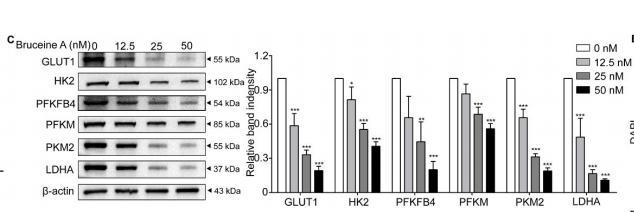PFKM Antibody - #AF7562
| 製品: | PFKM Antibody |
| カタログ: | AF7562 |
| タンパク質の説明: | Rabbit polyclonal antibody to PFKM |
| アプリケーション: | WB |
| Cited expt.: | WB |
| 反応性: | Human, Mouse, Rat |
| 予測: | Pig, Bovine, Horse, Sheep, Rabbit, Dog, Chicken, Xenopus |
| 分子量: | 85kDa; 85kD(Calculated). |
| ユニプロット: | P08237 |
| RRID: | AB_2843926 |
製品説明
*The optimal dilutions should be determined by the end user. For optimal experimental results, antibody reuse is not recommended.
*Tips:
WB: For western blot detection of denatured protein samples. IHC: For immunohistochemical detection of paraffin sections (IHC-p) or frozen sections (IHC-f) of tissue samples. IF/ICC: For immunofluorescence detection of cell samples. ELISA(peptide): For ELISA detection of antigenic peptide.
引用形式: Affinity Biosciences Cat# AF7562, RRID:AB_2843926.
折りたたみ/展開
6 Phosphofructokinase Muscle Type; 6-phosphofructokinase; 6-phosphofructokinase muscle type; EC 2.7.1.1; EC 2.7.1.11; GSD7; K6PF_HUMAN; MGC8699; muscle type; PFK, muscle type; PFK-A; PFKA; PFKL; PFKM; PFKP; PFKX; Phosphofructo 1 Kinase Isozyme A; Phosphofructo-1-kinase isozyme A; Phosphofructokinase 1; Phosphofructokinase M; Phosphofructokinase, muscle; Phosphofructokinase, muscle type; Phosphofructokinase, polypeptide X; Phosphofructokinase-M; Phosphohexokinase;
免疫原
A synthesized peptide derived from human PFKM, corresponding to a region within N-terminal amino acids.
- P08237 PFKAM_HUMAN:
- Protein BLAST With
- NCBI/
- ExPASy/
- Uniprot
MTHEEHHAAKTLGIGKAIAVLTSGGDAQGMNAAVRAVVRVGIFTGARVFFVHEGYQGLVDGGDHIKEATWESVSMMLQLGGTVIGSARCKDFREREGRLRAAYNLVKRGITNLCVIGGDGSLTGADTFRSEWSDLLSDLQKAGKITDEEATKSSYLNIVGLVGSIDNDFCGTDMTIGTDSALHRIMEIVDAITTTAQSHQRTFVLEVMGRHCGYLALVTSLSCGADWVFIPECPPDDDWEEHLCRRLSETRTRGSRLNIIIVAEGAIDKNGKPITSEDIKNLVVKRLGYDTRVTVLGHVQRGGTPSAFDRILGSRMGVEAVMALLEGTPDTPACVVSLSGNQAVRLPLMECVQVTKDVTKAMDEKKFDEALKLRGRSFMNNWEVYKLLAHVRPPVSKSGSHTVAVMNVGAPAAGMNAAVRSTVRIGLIQGNRVLVVHDGFEGLAKGQIEEAGWSYVGGWTGQGGSKLGTKRTLPKKSFEQISANITKFNIQGLVIIGGFEAYTGGLELMEGRKQFDELCIPFVVIPATVSNNVPGSDFSVGADTALNTICTTCDRIKQSAAGTKRRVFIIETMGGYCGYLATMAGLAAGADAAYIFEEPFTIRDLQANVEHLVQKMKTTVKRGLVLRNEKCNENYTTDFIFNLYSEEGKGIFDSRKNVLGHMQQGGSPTPFDRNFATKMGAKAMNWMSGKIKESYRNGRIFANTPDSGCVLGMRKRALVFQPVAELKDQTDFEHRIPKEQWWLKLRPILKILAKYEIDLDTSDHAHLEHITRKRSGEAAV
種類予測
Score>80(red) has high confidence and is suggested to be used for WB detection. *The prediction model is mainly based on the alignment of immunogen sequences, the results are for reference only, not as the basis of quality assurance.
High(score>80) Medium(80>score>50) Low(score<50) No confidence
研究背景
Catalyzes the phosphorylation of D-fructose 6-phosphate to fructose 1,6-bisphosphate by ATP, the first committing step of glycolysis.
GlcNAcylation decreases enzyme activity.
Cytoplasm.
Belongs to the phosphofructokinase type A (PFKA) family. ATP-dependent PFK group I subfamily. Eukaryotic two domain clade 'E' sub-subfamily.
研究領域
· Environmental Information Processing > Signal transduction > AMPK signaling pathway. (View pathway)
· Genetic Information Processing > Folding, sorting and degradation > RNA degradation.
· Human Diseases > Cancers: Overview > Central carbon metabolism in cancer. (View pathway)
· Metabolism > Carbohydrate metabolism > Glycolysis / Gluconeogenesis.
· Metabolism > Carbohydrate metabolism > Pentose phosphate pathway.
· Metabolism > Carbohydrate metabolism > Fructose and mannose metabolism.
· Metabolism > Carbohydrate metabolism > Galactose metabolism.
· Metabolism > Global and overview maps > Metabolic pathways.
· Metabolism > Global and overview maps > Carbon metabolism.
· Metabolism > Global and overview maps > Biosynthesis of amino acids.
参考文献
Application: WB Species: human Sample: MIA PaCa-2 cells
Application: WB Species: Mouse Sample:
Restrictive clause
Affinity Biosciences tests all products strictly. Citations are provided as a resource for additional applications that have not been validated by Affinity Biosciences. Please choose the appropriate format for each application and consult Materials and Methods sections for additional details about the use of any product in these publications.
For Research Use Only.
Not for use in diagnostic or therapeutic procedures. Not for resale. Not for distribution without written consent. Affinity Biosciences will not be held responsible for patent infringement or other violations that may occur with the use of our products. Affinity Biosciences, Affinity Biosciences Logo and all other trademarks are the property of Affinity Biosciences LTD.

